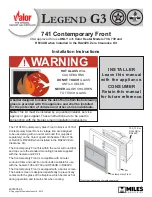
BLOWERS
DANGER: RISK OF ELECTRIC SHOCK.
DISCONNECT POWER BEFORE SERVICING UNIT.
Cleaning
– Over a period of time, ashes or dust may
collect on the blades of both the combustion blower
and convection blower. Periodically the blowers should
be vacuumed clean as these ashes can impede
performance. Creosote can also accumulate in the
combustion blower. This needs to be brushed clean.
The convection blower is accessed by removing the
stove’s left side panel. The combustion blower can be
accessed by removing the stove’s right side panel.
The convection blower is on the left (facing stove), and
the combustion blower is on the right.
NOTE:
When cleaning, be careful not to dislodge
balancing clip on convection blower or to bend fan
blades. Some stove owners lightly spray an anti-
creosote chemical on the fire to help reduce creosote
formation within the stove.
FIGURE 28
MAINTENANCE
20
FIGURE 29
Combustion
Blower
(A-E-027)
POF
Thermodisk
(C-E-090-22C)
Pellet
Hopper
Auger Shaft
(A-AUG-22)
Air Inlet
Tube
Combustion
Blower
(A-E-027)
Auger Motor
(C-E-017)
High Temp
Thermodisk
(C-E-090-21)
Convection
Blower
(A-E-033)
Air Switch
(C-E-200)






















